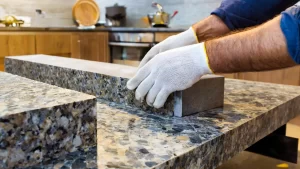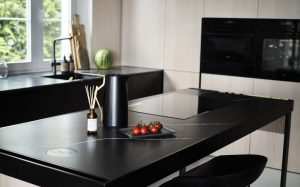Open-plan kitchens have become a hallmark of modern British homes, offering a fluid connection between cooking, dining, and living areas. By removing walls and barriers, these spaces encourage interaction, socialising, and a sense of openness that traditional kitchens often lack.
Yet, the very openness that makes them appealing can present design challenges, particularly when it comes to creating a cohesive aesthetic throughout the space.
Stone worktops provide a perfect solution, combining durability with elegance. They serve as a visual anchor, tying together various elements of an open-plan layout.
In this blog, we explore how to maximise aesthetic flow in open-plan kitchens using stone worktops, from selecting the right material to incorporating design techniques that unify your space.
Why Open-Plan Kitchens Need Cohesive Design
The absence of walls in open-plan layouts means every element, from cabinetry to flooring, is visible across the entire space. Without careful planning, this can result in a fragmented or cluttered look.
Cohesive design ensures that each area feels connected, creating a sense of harmony that is both visually pleasing and functional.
Worktops, in particular, play a key role in unifying an open-plan kitchen. By choosing materials and colours that complement surrounding furnishings, you can create a seamless transition between cooking, dining, and living zones.
This not only enhances the aesthetic appeal but also improves the overall flow of the space.

The Benefits of Stone Worktops in Open-Plan Layouts
Stone worktops are renowned for their durability, making them ideal for multi-functional open-plan kitchens.
They can withstand heavy use, whether it’s preparing meals, hosting dinner parties, or serving as a casual dining area. Their robust nature ensures that they remain a long-lasting feature in your home.
Beyond practicality, stone surfaces offer timeless beauty that complements a wide range of interior styles.
From sleek contemporary kitchens to cosy traditional spaces, natural and engineered stones provide versatility in colour, pattern, and finish. Low maintenance requirements further enhance their appeal, allowing you to enjoy both style and convenience.
Choosing the Right Stone for Aesthetic Flow
Granite is a popular choice for those seeking bold patterns and natural variation. Its unique veining and rich tones can create a striking focal point, perfect for islands or central work areas.
For those looking for uniformity, quartz offers a consistent finish that helps maintain visual continuity throughout the open-plan space.
Marble, with its elegant appearance, is ideal for feature areas such as kitchen islands or splashbacks, though it requires more care to prevent staining.
Porcelain and ultra-compact stones are increasingly popular, offering slim profiles and modern finishes that complement minimalist or contemporary interiors while remaining practical for everyday use.
Design Ideas to Create Seamless Flow
One effective way to create cohesion is by extending the same stone across multiple surfaces.
Matching kitchen islands and main worktops ensures a continuous visual line, while waterfall edges—where the stone extends to the floor—add drama and reinforce the sense of unity.
Colour coordination is another key consideration. Selecting a worktop that complements cabinetry, flooring, and soft furnishings helps tie the room together.
Incorporating stone into splashbacks or open shelving further enhances continuity, while careful lighting choices ensure the material’s tones are showcased beautifully throughout the day.
Practical Considerations
Open-plan kitchens can amplify sound, as hard surfaces such as stone reflect noise. Balancing this with soft furnishings, rugs, and acoustic panels can prevent the space from feeling overwhelming.
Additionally, the layout should support smooth movement between areas, avoiding congestion during busy periods.
Maintenance is also essential in high-traffic spaces. Stone surfaces should be regularly cleaned and sealed according to the manufacturer’s instructions to maintain their appearance and longevity.
By combining practical upkeep with thoughtful design, you can ensure your open-plan kitchen remains both beautiful and functional.

Conclusion
Stone worktops are a powerful tool for achieving aesthetic harmony in open-plan kitchens.
They provide both practicality and elegance, acting as a unifying element that enhances the overall flow of the space.
By carefully selecting materials, coordinating colours, and employing design techniques such as matching islands and waterfall edges, homeowners can create open-plan kitchens that are not only functional but also visually stunning.
Whether you are planning a renovation or designing a new home, stone worktops offer a timeless solution that elevates any open-plan interior.

